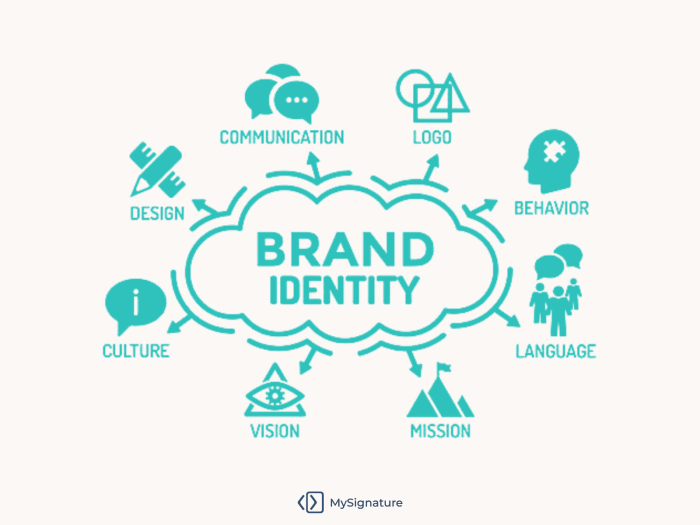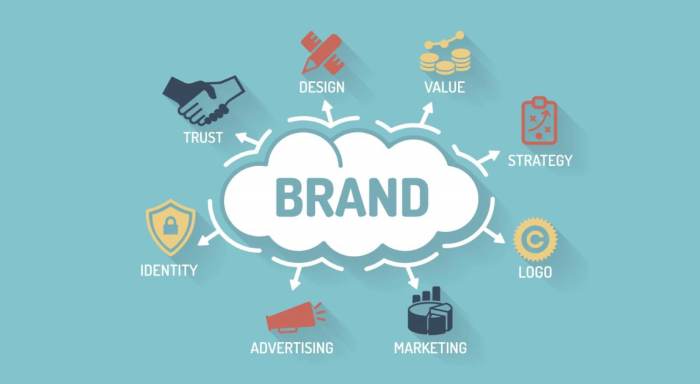Building a Visual Brand Identity sets the stage for creating a powerful and recognizable brand that resonates with your audience. Get ready to dive into the world of visual branding where colors, typography, and design choices play a crucial role in shaping brand identity.
Understanding Visual Brand Identity

Visual brand identity is all about how a company presents itself visually to the world. This includes elements like logos, color schemes, typography, and overall design aesthetic that help to create a cohesive and recognizable image for a brand.A strong visual brand identity is crucial for a company to stand out in a crowded market. It helps to communicate the brand’s values, personality, and message to customers at a glance.
Consistency in visual branding builds trust and loyalty among consumers, making it easier for them to recognize and connect with the brand.
Examples of Successful Visual Brand Identities
- Apple: Known for its sleek and minimalist design, Apple’s visual brand identity reflects its commitment to innovation and simplicity.
- Nike: The iconic “swoosh” logo and bold typography instantly convey a sense of athleticism and empowerment, making Nike a standout in the athletic apparel industry.
- Coca-Cola: With its distinctive red and white color scheme, classic logo, and timeless design elements, Coca-Cola’s visual brand identity has remained consistent and recognizable for generations.
Elements of Visual Brand Identity
Visual brand identity consists of several key elements that work together to create a cohesive and recognizable image for a brand. These elements include the logo, colors, typography, imagery, and overall design style.
Colors in Visual Branding
Colors play a crucial role in visual branding as they have the power to evoke emotions and convey the personality of a brand. Each color has its own associations and meanings, and the combination of colors used in a brand’s visual identity can communicate its values and message to the audience. For example, blue is often associated with trust and professionalism, while red can convey excitement and passion.
Consistency in color usage across all brand materials is essential for brand recognition and building a strong visual identity.
Typography in Reinforcing Brand Identity
Typography is another important element in reinforcing brand identity. The choice of fonts and typography styles can help convey the brand’s tone, personality, and overall message. Whether a brand opts for a sleek and modern font or a more traditional and elegant one, typography plays a significant role in shaping how the brand is perceived by its audience. Consistency in typography across all brand materials, such as websites, packaging, and marketing collateral, is crucial for maintaining a strong and cohesive brand identity.
Creating a Visual Brand Identity
Creating a strong visual brand identity is essential for any business looking to establish a memorable presence in the market. Here are some key steps to help you create a visual brand identity from scratch:
Designing a Logo
When designing a logo for your brand, it’s crucial to ensure that it aligns perfectly with your brand’s identity. Here are some tips to keep in mind:
- Research your target audience and competition to understand what resonates with them.
- Create a design brief outlining your brand values, mission, and personality.
- Choose colors, fonts, and imagery that reflect your brand’s identity and appeal to your target audience.
- Work with a professional designer to bring your vision to life and create a unique logo.
- Test your logo across different platforms to ensure it looks good and is recognizable in various settings.
Maintaining Consistency
Consistency is key when it comes to visual brand identity. Here are some tips to help you maintain consistency across different visual elements:
- Use your brand colors, fonts, and imagery consistently across all marketing materials and platforms.
- Create brand guidelines to Artikel how your logo, colors, and other visual elements should be used.
- Avoid making frequent changes to your visual identity to ensure brand recognition and build trust with your audience.
- Regularly review and update your visual brand identity to stay relevant and appealing to your target market.
Communicating Brand Identity through Design

Design choices play a crucial role in conveying a brand’s values and personality to the audience. From color schemes to typography, every element contributes to shaping the perception of a brand.
Role of Imagery and Graphics
Images and graphics are powerful tools in enhancing brand identity. They can evoke emotions, convey messages, and create a lasting impact on the audience. For example, a logo design can instantly represent a brand and its values, while visuals on social media can help reinforce brand messaging.
Design Strategies for Brand Messaging
- Consistent Visual Elements: Using consistent colors, fonts, and imagery across all platforms helps in creating a cohesive brand identity.
- Storytelling through Design: Design can be used to tell the story of a brand, connecting with the audience on a deeper level.
- User-Centered Design: Putting the audience at the center of design decisions ensures that the brand resonates with its target demographic.
- Minimalist Approach: Sometimes, less is more. A minimalist design approach can communicate sophistication and elegance.
Evolving Brand Identity Over Time: Building A Visual Brand Identity
In the fast-paced world of business and marketing, brands often find the need to evolve their visual identity to stay relevant and competitive in the market. There are several reasons why brands may need to make changes to their visual brand identity over time.One of the main reasons is to keep up with changing consumer preferences and trends. As consumer tastes and preferences evolve, brands must adapt to ensure they continue to resonate with their target audience.
Additionally, as a brand grows and expands into new markets or product lines, it may need to update its visual identity to reflect these changes and maintain consistency across all touchpoints.
Best Practices for Rebranding While Maintaining Brand Recognition
- Conduct thorough research: Before embarking on a rebranding effort, it is essential to conduct comprehensive research to understand the market, consumer behavior, and competitive landscape.
- Involve stakeholders: Engage key stakeholders, including employees, customers, and partners, in the rebranding process to ensure buy-in and support for the new visual identity.
- Evolution, not revolution: Rather than completely overhauling the brand identity, consider making incremental changes to avoid alienating existing customers while still attracting new ones.
- Consistency is key: Maintain consistency across all brand touchpoints, including logo, color palette, typography, and messaging, to ensure a cohesive brand experience.
- Communicate effectively: Clearly communicate the reasons behind the rebranding effort to internal and external audiences to build trust and understanding.
Case Study of a Successful Rebranding Effort and Its Impact, Building a Visual Brand Identity
One notable example of a successful rebranding effort is the transformation of Starbucks’ visual identity in 2011. The coffee giant updated its logo, removing the company name and solely featuring the iconic mermaid emblem. This move signaled Starbucks’ shift towards a more streamlined and modern image while still maintaining brand recognition.The impact of this rebranding effort was significant, with Starbucks successfully repositioning itself as a global lifestyle brand beyond just coffee.
The updated visual identity resonated with consumers and contributed to increased brand loyalty and engagement. Overall, the Starbucks rebranding case study showcases the importance of evolving brand identity to stay relevant and connect with consumers in a rapidly changing market landscape.
